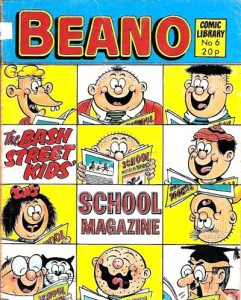Over at Comics Comics Tim Hodler dislikes the use of cropping in art books devoted to comics.
This probably demonstrates my ignorance, but I don’t like this trend of cutting up images, like an old movie pan ‘n scanned for VHS. (The same thing was done in Blake Bell’s Ditko bio and Chip Kidd’s Peanuts book, among others.) It’s an especially unwelcome practice in a “The Art of ______” book. I want to see ______’s art! I want to see how the artist composed the image, and I don’t really care if it looks good or bad. (Pretty much everything Jaime draws looks good, any way.) That is in fact a big part of my interest in such a book: tracking the artist’s development.
It’s unsettling to agree with Tim…but I agree with Tim. I have a fair number of fine art books in the house, and you know, I don’t see any of them doing this crap. If you have a book about constructivist art posters, say, they show you the whole damn poster, because they figure that’s what you’re there for. Books about Japanese prints show you the lovely Japanese prints. Sometimes they crop to show you close-up details, but it’s a far cry from the aggressive layouts you see in a lot of comics productions.
And you know what? I don’t actually know the names of the designers of any of those art books I own — almost as if everyone involved thought the artist in question was more important than the designer.
Anyway, there’s a long comments thread at Comics Comics, and designer Jacob Covey disagrees strongly with Tim. You can read Jacob’s whole impassioned comment at the link, but there were a couple of revealing remarks. First:
A lot of people bought that book [that is, the Chipp Kidd Peanuts book] precisely because of the design decisions and a lot of those people had a light shined onto the genius of Schulz. (In no small part because it gave some of his “edge” back after decades of sappy marketing.)
Got that? People bought it for Chip Kidd, who introduced a whole new audience to that unknown outsider artist, Charles Schulz. Because, you know, nobody had actually ever heard of Schulz until Kidd unearthed him and made him safe for hipsters (an idea which, among other things, is an insult to hipsters, most of whom are, like everyone else, perfectly capable of loving Schulz without having him spoon fed to them by a indifferently talented curatorial vulture.)
I did agree with this by Covey, though I don’t think it points quite in the direction he seems to think it does.
And, remember, this was a daily strip for the masses. It’s not the property of comics people. Schulz belongs to everybody and there’s a lot of ways to read him.
Schulz does belong to everyone. And you know who he especially belongs to? Kids. The thing I like least about the Chip Kidd Peanuts collection is that, with all the pictures of tschotzkes and all the cropping and all the strips produced at minute sizes, it’s very difficult to read the book to my son. I gave it a try or two because the boy is so obsessed with Peanuts at the moment — but the whole endeavor was an exercise in eye strain and frustration. Eventually I just put the collection back up on the shelf and vowed to stick with the also-overdesigned-but-at-least-user-friendly fanta complete collections.
Basically, if you create a Peanuts book that parents can’t easily read to their kids, I think I’m justified in saying you’ve failed. And I further think I’m justified in suggesting that you’re a pretentious fuck who deserves a swift kick in the pants.


